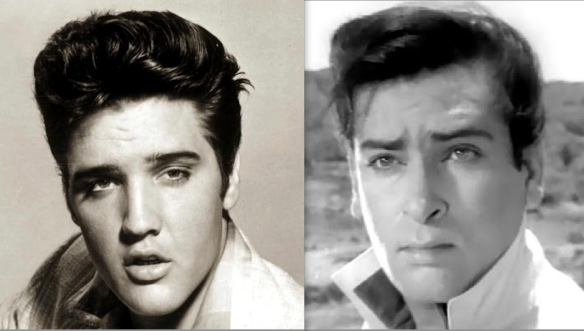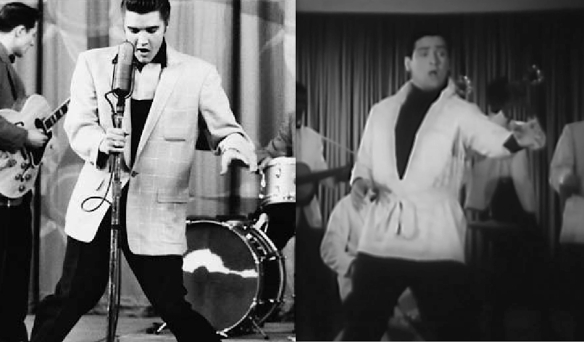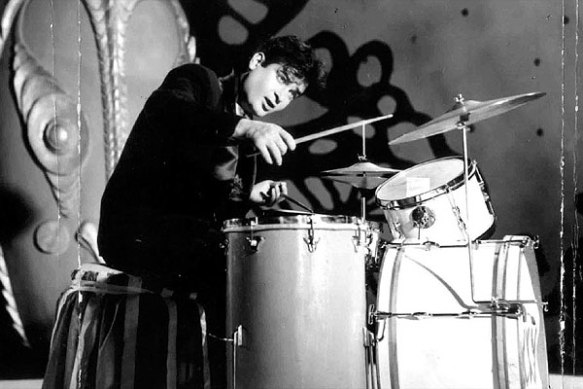Bollywood actor Shammi Kapoor (1930-2011) was popularly known as the Elvis of India. I just got back from a road trip with my fiancé down to Graceland, home of the original King. Despite jamming out to “That’s All Right Mama” as we toured around, I couldn’t help but think of Bombay film legend Shammi Kapoor and the famous media comparison. I’m a diehard Elvis Presley fan, and my love for his Indian counterpart is no less. But is it even fair to correlate the two?
When I first heard of the comparison of yesteryear Bollywood actor Shammi to American rock-and-roll legend Elvis, I needed a little convincing. All right, I needed a lot of convincing. Nothing short of blasphemy is on the line when you start comparing yourself to the King. I grew up listening to Elvis and had seen Shammi Kapoor films like an Evening in Paris (1967), Brahmachari (1968), Prince (1969) and Andaz (1971). The slightly overweight Bollywood thespian with heavy pancake makeup and tight pants was a far cry from the jailhouse rocking Elvis Presley I knew so well. After all, anyone can wear a pair of tight pants in public, but not everyone should.
So why then do we call Shammi Kapoor the Elvis of India? To begin to answer this, we must go back in time. We return to Shammi Kapoor’s earliest hits films in the days before even the rip-roaring success of Junglee (1961): movies like Tumsa Nahin Dekha (1957) and Dil Deke Dekho (1958). Suddenly, the similarities in appearance are clear. Sure in later colour films Shammi Kapoor didn’t look much like Elvis, but let’s face it, by the time the 70s rolled around, Elvis didn’t look much like Elvis either.

Unintentional twins, Elvis Presley (left) and Shammi Kapoor (right) revolutionized the entertainment industry complete with popped collars and pompadours.
But the comparison of the two entertainment icons goes beyond mere appearance. Elvis brought with him a cultural revolution in the midst of a tumultuous political atmosphere in the U.S. Shammi Kapoor, I would argue, brought that same youthful rebellion to India. Before Shammi Kapoor, no actor had ever so deliberately and daringly sought to appeal to the “modern youth” audience on-screen. Before the Shammi revolution, popular actors like Ashok Kumar, Guru Dutt and even Raj Kapoor appealed to a more traditional, elder protagonist who often encountered a modern society—but did not speak for it. Shammi was different.

Both Elvis (left) and Shammi (right) pose with their convertibles, hands on hips and one button too many unbuttoned.
With edgy attire, a boyish charm to mask his sharp tongue and a irreverent eye for the ladies, Shammi burst onto the Bombay scene with never-before-seen sex-appeal. He voiced the thoughts and emotions of a new generation who didn’t play by the rules of their fathers—Shammi flirted shamelessly in his movies, played the drums like a rockstar in his songs, and never failed to bring a sleek pompadour ‘do to the set to balance the party happening in his hips. Before Shammi, such actions would have been downright villainous, reserved only for the drunk antagonist of the film who would never win the pure-hearted girl. But Shammi changed the game.
He oozed that James Dean sense of self-confidence so despised by the older generations and so adored by young women everywhere. Watch his peacock strut in “Baar Baar Dekho” from Chinatown (1962), and the way Mohammed Rafi throws in a suave “Tally ho!” into the mix as Shammi coolly slams his guitar. Those signature hip gyrations would have done the King proud!

Elvis Presley and Shammi Kapoor strike similar poses in even more similar outfits. Left: Elvis performing “Jailhouse Rock” in 1957. Right: Shammi Kapoor swinging to “Dilruba Meri Neeta” in Dil Deke Dekho (1959).
The heart of the revolution, of course, lay with the music. Elvis combined his Southern gospel routes with African-American rhythm and blues to create a whole new catchy sound that caught the country by storm. It was a wave that Shammi Kapoor brought to Bombay. Through radical compositions that drew upon rock-and-roll themes, sassy lyrics, and Mohammed Rafi’s energetic and versatile vocals, Shammi Kapoor too changed the face Bollywood music, ushering an era of fusion-inspired hits from “Bolo Bolo Kuch To Bolo” to “Aaja Aaja Main Hoon Pyaar Tera.”
As Shammi Kapoor said in a Times of India interview before his death:
“My style was unique, but it would have come to nothing had it not been for such brilliant music directors like O. P. Nayyar and Shankar-Jaikishan. I was this supremely macho guy and within me lay dormant an incredible energy that was screaming for expression. Luckily for me, my directors sensed the potential in me and allowed me to unleash my creativity. I guess I also had this very innocent way of looking at girls that heightened the romance element in my films.”

My visit to Graceland, home of the King of Rock and Roll. Left: Boarding one of Elvis’ private jets named for his daughter Lisa Marie. Right: Giving the King a little help holding up a gold record!
The truth of the matter is, Shammi Kapoor never said he modeled himself off of Elvis and never mentioned him in any interviews. Although their legacies share some similarities, the two men never met nor made any attempt to do so. The parallels that link their names together are those that we their fans imagined as observers. The late Shammi Kapoor did not achieve fame in an era where concert videos of Elvis could be watched or copies of the King’s films reviewed over and over again. Shammi insisted that all his choreography was extempore, straight from his heart. In fact, the only direct Bollywood copy of an Elvis hit was “Marguerita” (1963) picturised as “Kaun Hai Jo Sapnon Mein Aaya” by Rajendra Kumar in 1968.
So ultimately, perhaps it is an injustice to say that Shammi Kapoor imitated Elvis Presley’s style. After all, many men around the world knew how to shake their hips and puff their hair, but how many could bellow “YAHOO!” to the object of their affection and get away with it?
Perhaps it would be better to call Elvis the Shammi Kapoor of America.
– Mrs. 55


Lovely post! IMO ,both were great in their own league.Another similarity or perhaps direct imitation,a scene from “An Evening in Paris”,where Shammi pays a young boy to to kick him in the shins to meet Sharmila; was an exact repilca from Elvis’ film “It Happened at the World’s Fair” (1963), where Elvis also pays a young boy to kick him in the shins.And the actor who played the young boy in Elvis’ film was American television and film actor. Kurt Russell………………….
Great trivia!! Thanks for sharing! Was it mere coincidence that the scenes were so similar? Regardless, you’re right–both performers were absolutely brilliant in their own right!
This is a new way to look at Shammi that I had never thought of before. I knew Raj Kapoor was very obviously copying Charlie Chaplin. Very clever!!!! Who else who else I ask?
It’s true! Raj Kapoor openly tried to imitate Charlie Chaplin, but then added his own unique spin that eventually became completely his own. The Kapoor family was indeed special, bringing such vivid personas and strong visions to the silver screens of Bombay. It’s hard to directly compare other actors or directors to international counterparts who have had such a profound impact!
When I first saw ‘Tumsa Nahin Dekha’, as a kid, I was almost shocked and exhilarated at the same time. Shammi was unique, his mannerisms oozing self-confidence, something we had never seen on the screen before. I thought it was more James Dean than Elvis. However, I totally agree with you, it was Elvis Presley who was the Shammi Kapoor of America, as the great Amir Khan would say.
Tumsa Nahin Dekha is one of my favorite Shammi Kapoor films! I own it on DVD and must have seen it a dozen times. It’s quintessential for the era! Thanks for reading!
Awesome blog. I did that Graceland tour when I worked in Memphis – lots of memories. Interestingly I started off playing Elvis songs on guitar and now I’m studying the raagas and more into performing Hindi songs – back to my roots! Your blog puts these songs into a great perspective from a performers viewpoint. One can get the true inner feeling of a song from your write-ups Keep up the excellent work!
That sounds fantastic! We fell in love with Memphis when we visited–it’s such a musical hotspot and filled with culture. Nice to hear you’re experimenting more with Hindi music–there’s nothing like it!!
Very informative and very well written. Your homework was well done. Enjoyed reading it.
What a brilliant comparison between Shammi Kapoor and Elvis Presley! I hope you enjoyed your road trip to Graceland with your fiance!
Nice article, and a great tribute the original ”Yahoo” man. I am glad someone besides me feels that Shammi was unique and did not necessarily imitate Elvis. And True, Elvis didn’t look that great in the 70’s, drugs and depression affected his good looks, sad. But he was a superb performer until the day he died.
About your statement where you mention that there was no actor that spoke to the youth before Shammi (or something along those lines), What about Dev Anand?? He was 50’s Bollywood Rebel ‘with’ a cause. And among the actresses, the likes of Nutan and Madhubala were very energetic youthful stars of the 50’s as well.
And the last line, I’ve also often wondered why it can’t be other way round as well. Hollywoods Amitabh Bachchan, Hollywoods Parveen Babi etc etc…
Agreed–whatever Elvis may have looked like toward the end, he never lost his touch. I don’t know if I would consider Dev Anand in the same category–he usually played a man with a heavier social mission than Shammi Kapoor. But you’re right about Nutan and Madhubala–who can forget Nutan’s brilliantly bratty performance in Chori Chori! I think slowly but surely Hollywood is recognizing the power of Indian films–and the actors that made them famous!
Shammi Kapoor was unique in the sense that he appealed to the Indian youth who were westernised, especially in the late 1950’s and 1960’s. He rebelled against conventions, and his songs were more jazzier with rock’n’roll influence. Something not seen on the Indian screen before. I do not think that Dev Anand was a rebel in any way.
Pingback: Shammi Kapoor-Tum Mujhe Yun Bhula Na Paaoge | coolone160
Pingback: Do Lafzon Ki Hai Dil Ki Kahani Lyrics and Translation: Let’s Learn Urdu-Hindi | Mr. & Mrs. 55 - Classic Bollywood Revisited!
Pingback: Hindi Film Songs with Unnecessary English: Fusion Lyrics in Old Bollywood | Mr. & Mrs. 55 - Classic Bollywood Revisited!
It was great to see Shammi complement the singer (Rafi) and musicians (SJ, OP) that gave the ELVIS tag currency……….latterly RD also knew how to exploit the RAFI/SHAMMI combo-(Tumne Mujhe Dekha)-for the appropriately rockstar avatar in Teesri Manzil.
Rafi was no doubt the closest voice-over for Shammi, and countless nominations (FilmFare) are proof of that…..
One of my favorites is “Aye Gulbadan..” from the evergreen musical “Professor”, -in fact, every number in that SJ album was melodious.
Others…………..
Dilke jharoke men, Brahmachari
Main gaoo tum so jao,
Is rang badal ti duniya men, Rajkumar
Tum mujhe yu Pagla Kahin Ka
of course. the list is long
While Elvis Presley is my idol, Shammi Kapoor is my most favorite Indian actor. It was because of my likeness for Shammi Kapoor that I even got to know about Elvis Presley when I was a 15.
Long live both great legends!
Pingback: Wow! These Bollywood And Hollywood Celebs Could Be Twins